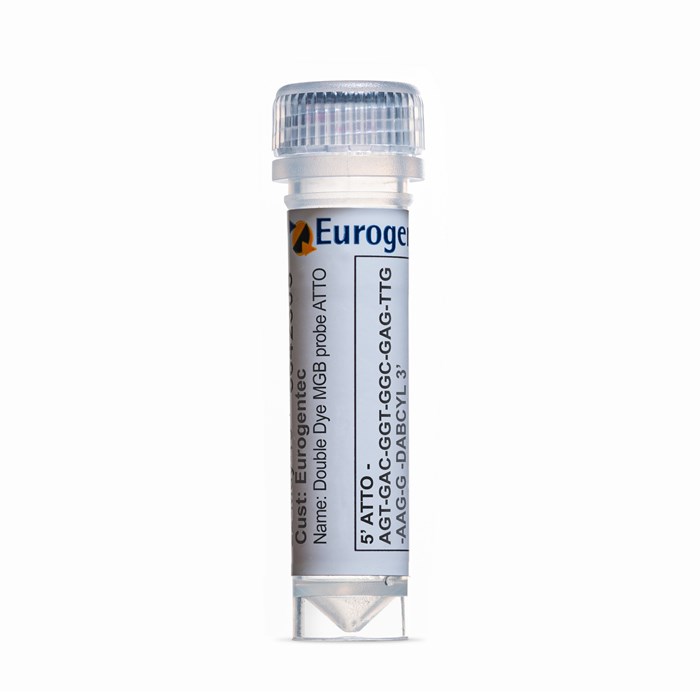Double Dye MGB probe 5' ATTO-labelled - 1 probe
- Cat.Number : PB-MGBEA-006
- Manufacturer Ref. :
-
Availability :
In production
Minor Groove Binder probes (MGB Probes) are double-dye probes forming highly stable duplexes with their targets. MGB Probes have a fluorescent reporter dye and a quencher at their 5’ and 3’ ends, respectively. The MGB moiety is linked to the Quencher at the 3’ end.
The minor groove binder increases the Tm of a probe. Therefore MGB probes are more specific, more efficient and more sensitive than standard dual-labelled probes.
Relying on a 35-year expertise in oligonucleotide manufacturing, Eurogentec provides high quality MGB-Eclipse® probes perfectly suited for any application.
Benefits
• High signal to noise ratio for sensitive detection
• Delivered quantities: 6 - 20 - 50 nmol
• Custom scales on request
• Complete offer: More than 15 Dyes available, covering all qPCR channels
• Free Wobble bases: Available at no additional cost
MGB probes are RP-HPLC purified and controlled by MALDI-TOF Mass Spectrometry and HPLC. MGB probes can be provided in solution or dried in bulk or aliquoted in separate vials.
How do the MGB probes work?
MGB Probes are designed to anneal between the upstream and downstream PCR primers.
During the amplification process, the 5’-> 3’ exonuclease activity of the Taq DNA polymerase cleaves the fluorophore from the probe. Since the fluorophore is no longer subjected to FRET quenching, it starts to fluoresce. This fluorescence can be measured, and the level is directly proportional to the amount of target DNA accumulating during the PCR reaction.
Fluorescent Dyes:
ATTO 390 - Absorbance = 390 nm, Emission = 479 nm
ATTO 425 - Absorbance = 436 nm, Emission = 484 nm
ATTO 465 - Absorbance = 453 nm, Emission = 508 nm
ATTO 488 - Absorbance = 501 nm, Emission = 523 nm
ATTO 495 - Absorbance = 495 nm, Emission = 527 nm
ATTO 520 - Absorbance = 516 nm, Emission = 538 nm
ATTO 532 - Absorbance = 532 nm, Emission = 553 nm
Specifications
| Modification | |
| Post Synthesis Coupling |
|
|---|---|
| Quantity & Purity | |
| Purification Method |
|
| Storage & stability | |
| Resuspension condition |
|
| Storage Conditions |
|
| Codes | |
| Code Nacres |
|
